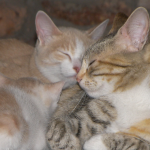Cats, known for their curiosity, often stumble upon bugs that can lead to skin troubles. Identifying and comprehending these common bug bites not only aids in timely treatment but also in preventing these encounters.
Fleas: These tiny, wingless insects often leave telltale signs of their presence before the bites become evident. Flea bites, typically spotted around a cat’s neck, back, and tail, appear as raised red or pink spots or clusters. Prevention entails year-round flea control using vet-recommended products.
Ticks: Recognizable as small round bumps on a cat’s skin, ticks leave behind circular wounds after feeding. Regular tick prevention measures, including topical treatments, are crucial to avoid tick-borne illnesses.
Mites: Mites cause various skin irritations, including itchiness, inflammation, and even hair loss. Ear mites might be visible as tiny white specks. Treatment involves FDA-approved medications, while prevention often intertwines with routine flea and tick control.
Mosquitoes: Beyond inducing skin lesions and red raised bumps, mosquitoes pose the grave risk of transmitting heartworm disease to cats. Employing pet-safe mosquito repellents in areas prone to mosquito bites is essential for prevention.
Bees/Hornets/Wasps: Though causing localized swelling and tenderness, these stings can occasionally trigger allergic reactions in sensitive cats. Immediate removal of stingers and prompt vet advice are essential, particularly for possible allergic reactions.
Ants: Ant bites result in red raised bumps, sometimes with pus pockets, leading to itching and localized discomfort. Vigilance, especially when cats are outdoors, aids in spotting ant bites early. Seek veterinary guidance on the appropriate treatment.
Preventing Bug Bites:
- Pet-Safe Repellents: Use pet-friendly bug repellents and avoid indoor pesticide use after consulting with a vet.
- Limit Outdoor Exposure: Reduce outdoor time, especially during peak bug activity, and regularly inspect your cat’s fur and skin.
- Yard and Home Treatments: Employ pet-safe bug control products in yards and homes to minimize exposure risks.
Consulting a veterinarian for guidance on suitable preventatives and treatments is pivotal to protect your cat from bug bites and associated skin irritations. Early detection and timely action significantly mitigate the risks associated with these common bug encounters.




